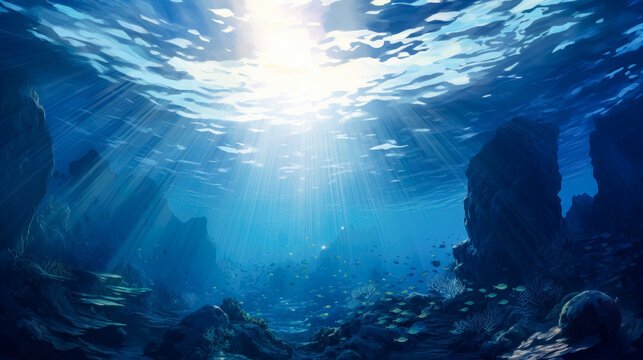
Let’s take a dive into and know about the 11 scariest things about Ocean. These facts about ocean will blow your mind and will enhance your eagerness to know more about the ocean body.
Just 10% of our seas have been thoroughly investigated, yet in that little portion, we have found locations where the pressure is strong enough to crush an adult human body. In addition, the waters serve as the backdrop for erratic and catastrophic natural events like hurricanes, tsunamis, and whirlpools.
The ocean, covering about 70% of the Earth’s surface, is a vast expanse of saltwater that plays a crucial role in shaping the planet’s climate and sustaining diverse ecosystems. Comprising interconnected and dynamic bodies, oceans influence weather patterns and absorb carbon dioxide, helping regulate the global climate. Rich in biodiversity, oceans are home to a myriad of marine species, from microscopic organisms to majestic whales. They provide vital resources for human sustenance, supporting fisheries, transportation, and trade. Moreover, oceans inspire awe with their sheer magnitude, depths, and mysteries, fostering a sense of wonder and fascination with the beauty of our planet’s aquatic realms.
The Pacific, Atlantic, Indian, Arctic, and Southern Oceans are the five main regions that make up the ocean, despite the fact that it is a single, uninterrupted body of water. Around Antarctica, the Atlantic, Indian, and Pacific Oceans combine to form frigid waters.
Let’s jump into the – Scariest Things About Ocean
1. Ten million viruses may be found in one milliliter of ocean water
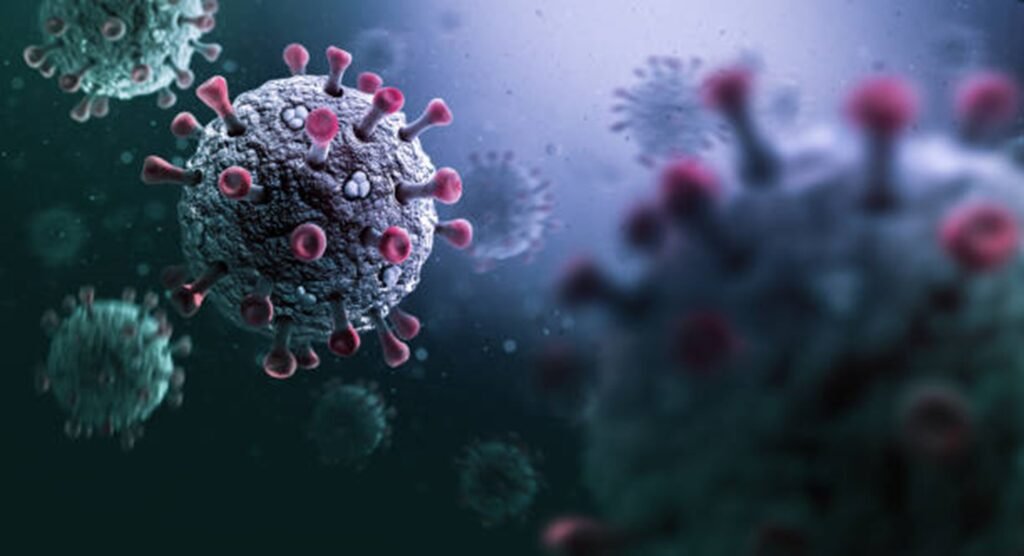
It could surprise those who are not familiar with marine microbiology to learn that there are 1 million bacteria and 10 million viruses in 20 drops (1 mL) of saltwater. When beaches are blocked or warnings are issued, it’s usually because tests on certain bacteria in the water suggest that dangerous bacteria, viruses, protozoa, or parasites are probably present. This unpredictable phenomenon makes the scariest things about ocean. As we approach the open sea, the quantity of viruses diminishes as we descend more offshore and into the ocean. At 4,000 meters, we may expect to find about 100,000 viruses per milliliter. While the total number of viruses stays relatively stable over time, countless more emerge from infected hosts and countless more are consumed by microbes or rendered inactive by radiation. In saltwater, there is a dynamic equilibrium between the vanishing of viruses and the emergence of new ones.
2. You will truly be crushed to death by the ocean’s depths.
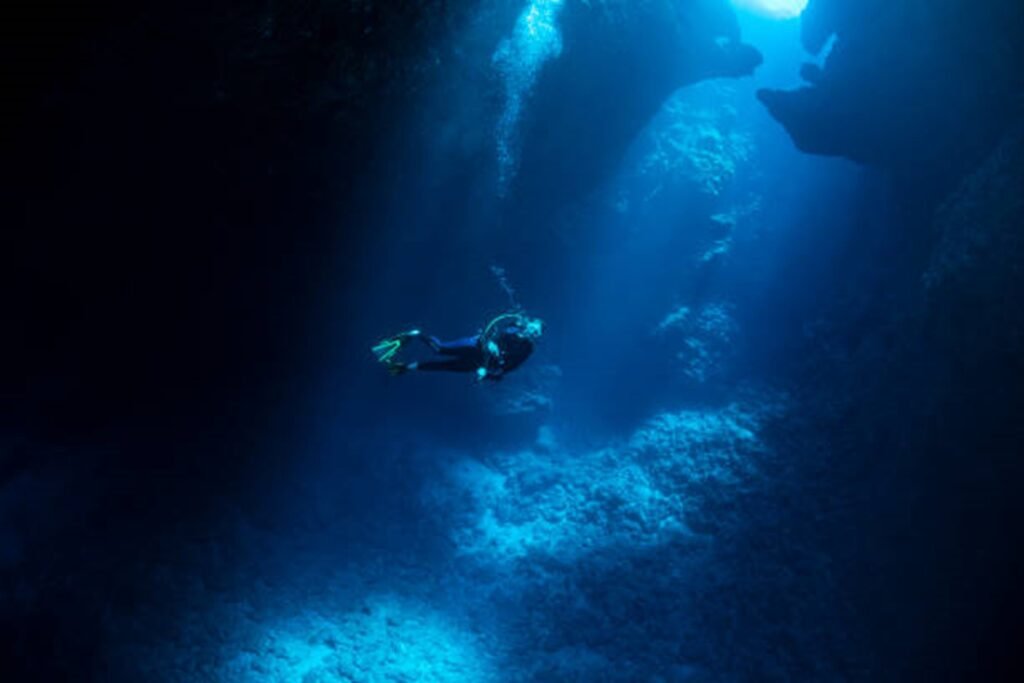
It seems sense that the pressure of deep water may make someone feel as though they are being smothered. Water presses against your body from all sides when you’re submerged , these sacriest things about ocean is treacherous . Hydrostatic pressure is the force that exists in water that is greater than that which exists on land. This pressure will be greater the more water there is above you. This is a really strong force that will finally break you. The ocean’s average depth is 12,100 feet. However, most divers are told to limit their dives to no more than 130 feet. If you go any farther, the increased hydrostatic pressure might cause your lungs to collapse. This pressure would effect your brain, lungs and may cause paralysis or death.
The primary rationale behind the 40 meters/130 feet recreational diving depth limit is safety. You can, in fact, get beyond this point, but doing so will need expert diving abilities. Depending on the depth you reached, you may need to utilize various gas combinations and make decompression pauses if you descend below 40 meters (130 feet).
3. Unexplored areas of the ocean still exist.
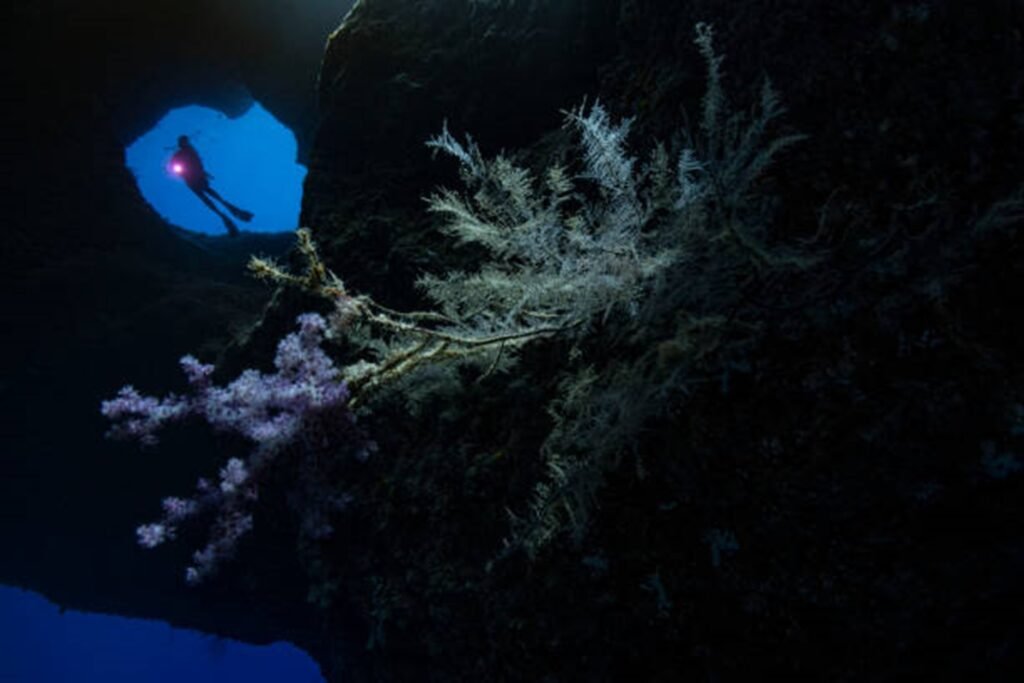
Over 80 percent of the ocean is still uncharted. Additionally, only around 7% of the world’s seas are classified as marine protected areas (MPAs) due to the difficulty of protecting what we do not fully understand.
Ocean exploration is costly and technologically difficult also. The ocean’s average depth is 12,100 feet. The pressure caused by the weight of the saltwater above at this depth is more than 300 times higher than the pressure we feel at the ocean’s top. The pressure is more than 1,000 times higher at the ocean’s deepest point, which is around 36,000 feet below the surface.
There’s also another reason why the chemical composition of seawater causes electrochemical processes that might lead to metal degradation. Deep-sea robots need to be able to endure the corrosive qualities of saltwater in addition to having to withstand tremendous pressure and extended dive periods. Today’s submersibles employ polymers to form a barrier between the seawater and the metal framework of the submersible, preventing corrosion.
4. The oceans contain enough salt to cover the whole surface of the planet
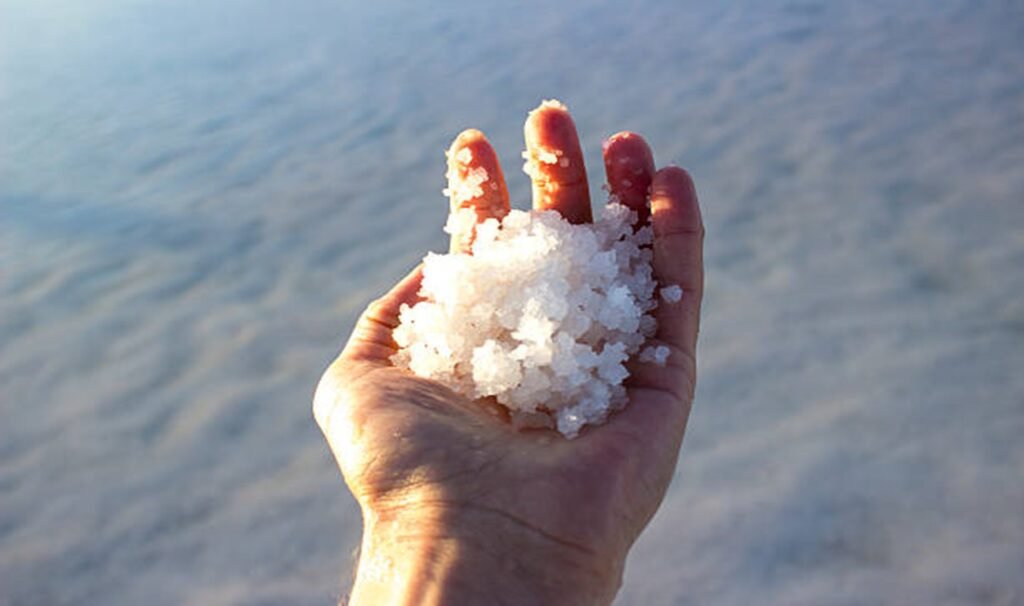
Seawater is a complicated combination consisting of 96.5 percent water, 2.5 percent salts, and minor quantities of particles, a few air gases, and dissolved inorganic and organic compounds.
A layer of salt more than 500 feet (166 meters) thick—roughly the height of a 40-story office building—would emerge if all of the salt in the ocean were to be taken out and uniformly distributed across the surface of the Earth. Why is there salt in the ocean? The majority of this salt is derived from land-based rocks, which are carried to the sea via riverine inputs and rainfall runoff. Hydrothermal vents on the bottom can also propel it into the ocean.
The scariest things about ocean is it’s underwater volcanic eruptions, or submarine volcanism, are responsible for the salts found in the water body. The way that saltwater reacts with heated rock to dissolve some of the mineral components makes this process comparable to the one that came before it.
5. It is unclear how many species exist in the ocean
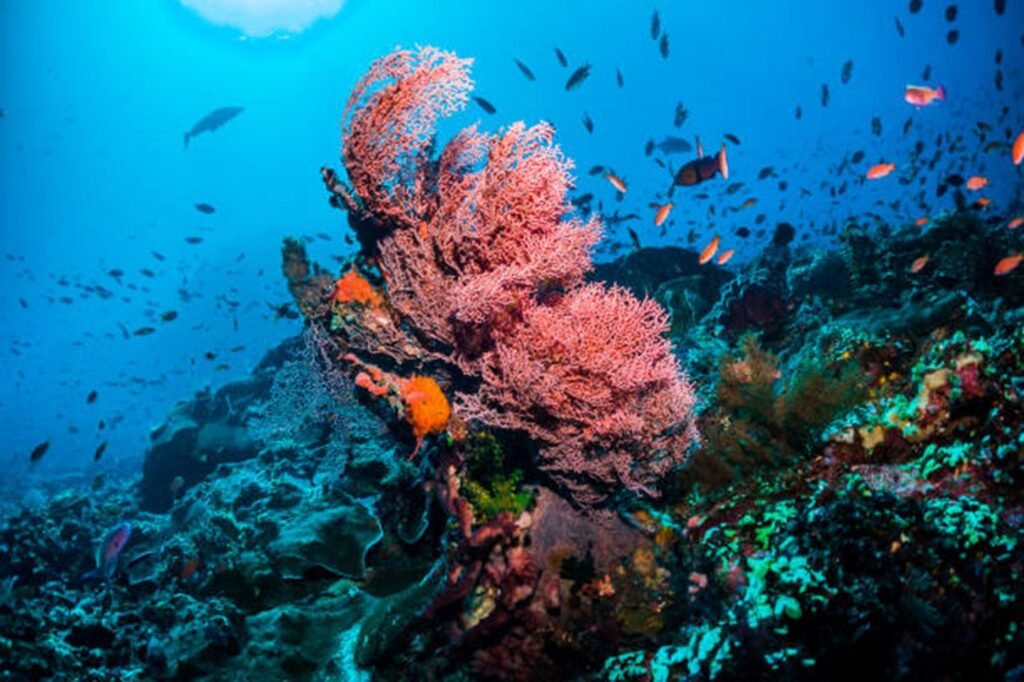
According to Ocean Census, scientists estimate that only 240,000 of the 2.2 million marine species they expect to be present in Earth’s seas have actually been discovered. Scientists believe that about 80% of our ocean is unmapped, unseen, and undiscovered, and that 91% of ocean species have not yet been categorized, which makes it the scariest things about ocean as many factors are still untraveled.
Furthermore, according to recent studies, many species are disappearing before we get an opportunity to study them due to extinction rates.
The rate of extinction and the ongoing degradation of many ecosystems suggest that species’ capacity to adapt to the ever-changing conditions of our planet are probably being surpassed. However, not all of the news is awful. To aid in the development of fresh approaches for the preservation of essential ocean ecosystems, scientists from all over the world are still studying marine life and its habitats.
6. At the bottom of the ocean, there are said to be over 3 million shipwrecks
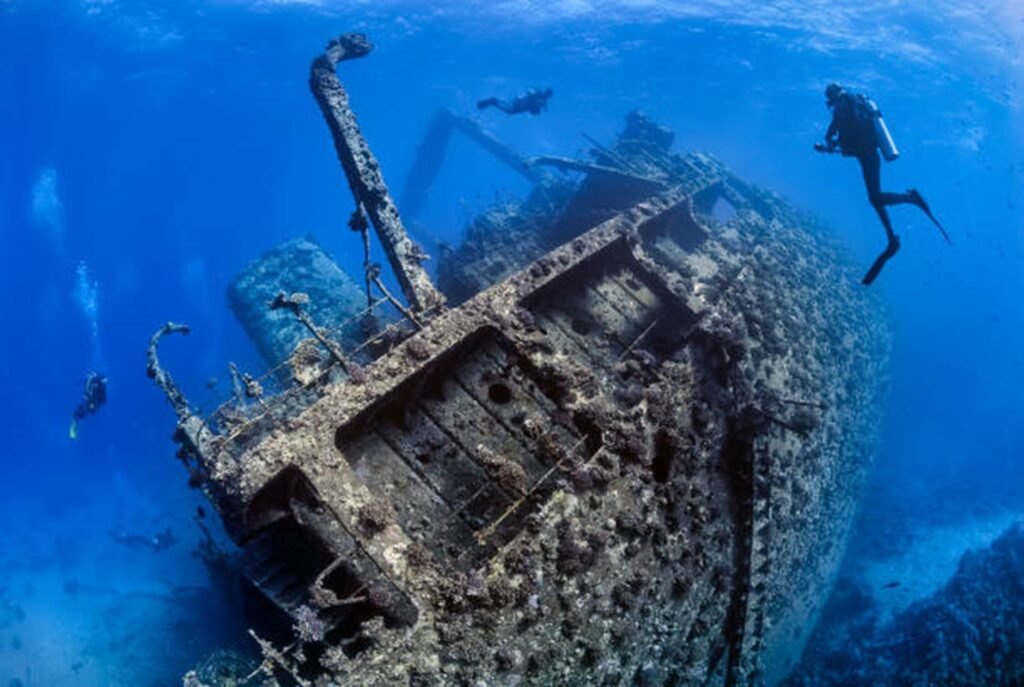
An estimated three million shipwrecks may be found strewn across the ocean floor, ranging from little abandoned dinghies to sunken World War II destroyers and historic Spanish galleons. This is considered to be the scariest things about ocean, because of the reason, as many of them are alive with marine life, having been reclaimed by the water and used as homes by sharks, eels, coral, and snappers.
In actuality, less than 1% of these wrecks have been investigated. While many wrecks are discovered by chance, some, like the Bonhomme Richard, are actively being searched for. The biggest passenger ship on the ocean floor is the wreck of HMHS Britannica. With a date of 2700–2200 BC, the Dokos shipwreck is the oldest wreck ever discovered.
The most well-known disaster, but not the largest in terms of lives lost, was likely the British ocean liner RMS Titanic, which sank in 1912 and claimed the lives of over 1,500 people.
It is anticipated that this decade would see the highest amount of marine pollution from sunken boats, with over 8,500 shipwrecks potentially spilling over 6 billion gallons of oil.
7. Ocean Depths: Where Sunlight Fades
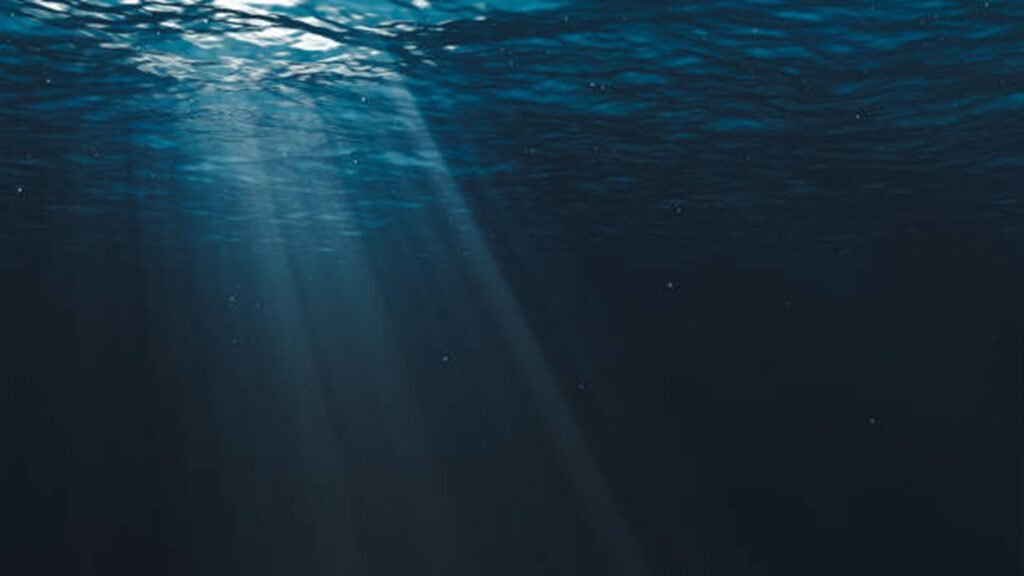
The scariest things about ocean are its dimness and darkness. The ocean is incredibly deep; light can only go approximately beyond the ocean’s surface. The molecules in the water scatter and absorb the light energy as it passes through them. Light scatters so much at extreme depths that there is nothing left to detect.
Based on depth and light intensity, the water is split into three zones. The term “sunlight,” or euphotic zone, refers to the upper 200 meters of the ocean. The great majority of commercial fisheries are found in this zone, which is also home to numerous sea turtles and aquatic creatures that are preserved. The aphotic zone is found at lower than 1,000 meters. Below a 1000 meters lies the aphotic zone. The area is completely black since sunlight cannot reach these depths. The aphotic zone is further separated into the hadopelagic at 6,000 meters and below, the bathypelagic zone between 1,000 and 4,000 meters, and the abyssopelagic between 4,000 and 6,000 meters.
8. Mountains down the ocean
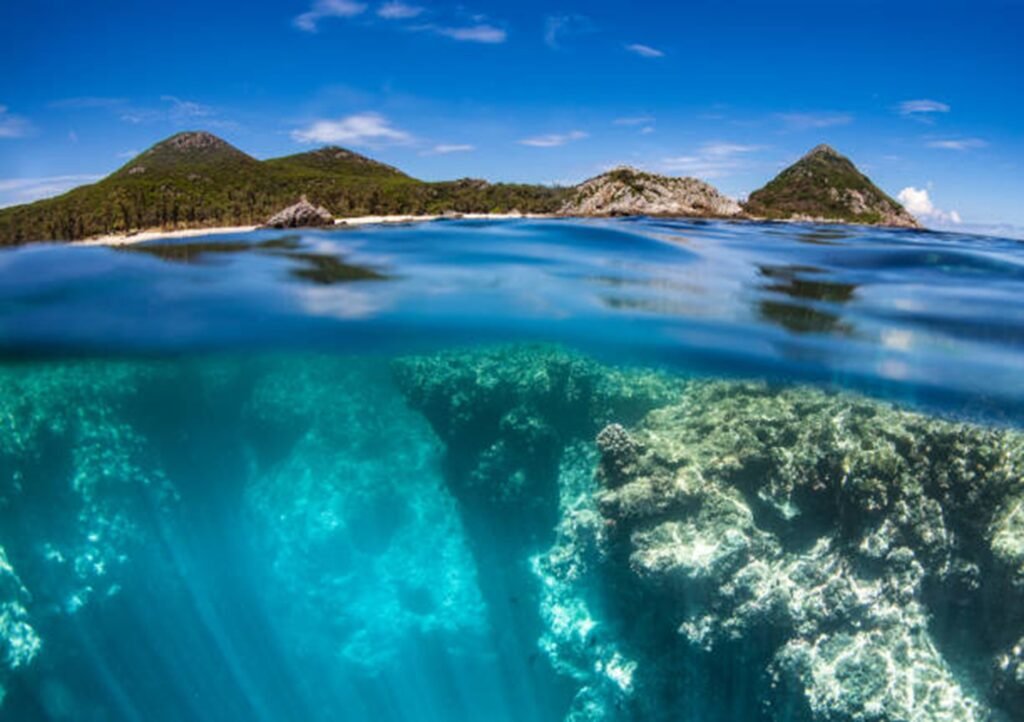
The overriding oceanic plate gets absorbed by the Earth’s mantle when two oceanic plates clash. Magma rises from the descending plate during that process, causing an eruption that can create seamounts and islands.This occurence makes the scariest things about ocean body.
Mountain ranges that are partially or totally submerged—that is, beneath the surface of an ocean—are known as underwater mountain ranges. When they arise from present-day tectonic processes, they are commonly known as mid-ocean ridges. In contrast, they are referred to as a seamount chain if they were created by previous above-water volcanism. Large volcanic mountains that are buried under the water and were created by volcanic activity are known as seamount. Few mountains under sea are – Mauna Kea (10,000 metres), Muirfield Seamount (approximately 5,000 metres), Adams Seamount (3,500 metres) Walters Shoals (4,750 metres), etc
9.The deepest point – Mariana Trench
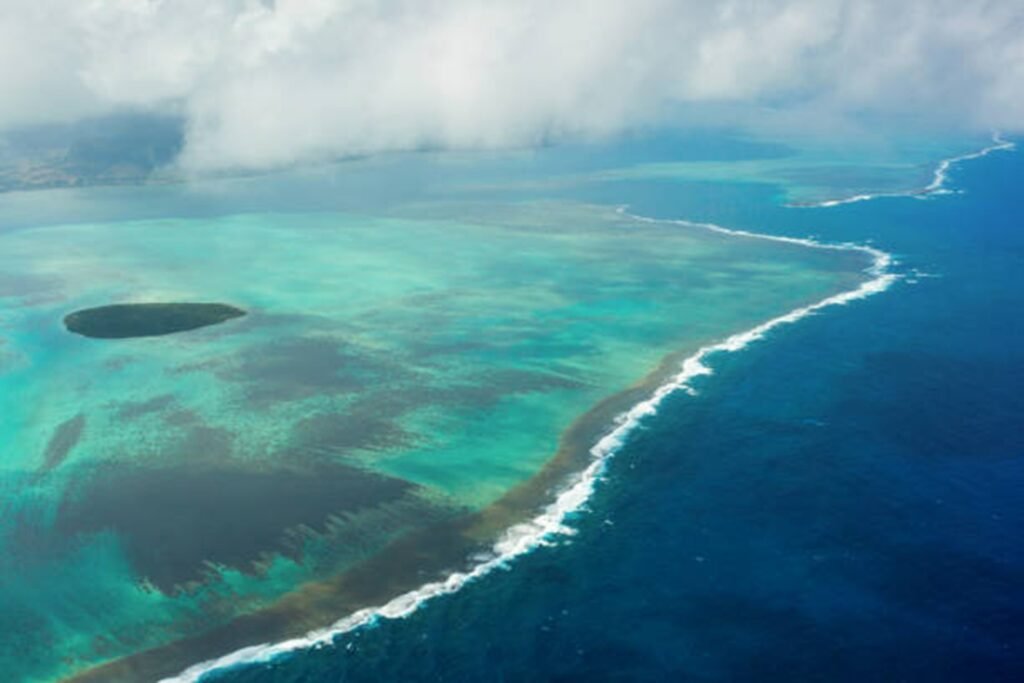
The Mariana Trench, a chasm in the western Pacific Ocean that stretches more than 1,580 miles (2,540 kilometres) and is home to the Challenger Deep, the deepest known point on Earth’s surface that descends more than 36,000 feet (roughly 11,000 meters) underwater, is arguably the most fascinating of these features, and the scariest things about ocean. Challenger Deep was named after the British ship H.M.S. Challenger, whose crew made the initial discovery of the Mariana Trench in 1875. The Pacific Plate to the east and the Philippine Sea Plate to the west are the two tectonic plates involved in the Mariana Trench. Concerningly, the pressure in the Challenger Deep is almost 1,100 times more than the air pressure our bodies are accustomed to, meaning that you may actually be crushed to death by the ocean.
The Mariana Trench is well-known for its National Wildlife Refuge, which safeguards the world’s deepest known habitats and maintains its biological diversity. It also offers opportunities for the conservation, management, and restoration of fish, wildlife, plants, and other scientifically significant objects.
10.The Mysterious Bermuda Triangle
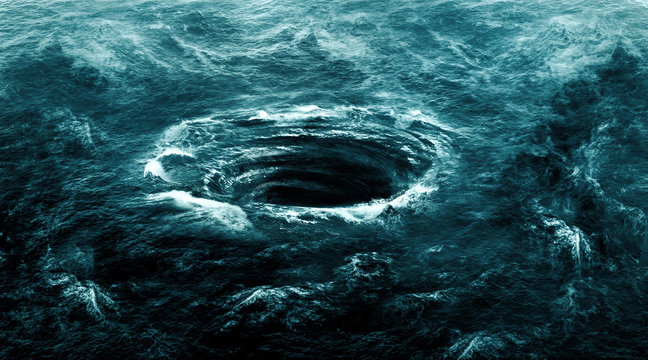
The Devil’s Triangle, often known as the Bermuda Triangle, is a region in the western North Atlantic Ocean where commercial ships, boats, and airplanes have mysteriously disappeared. There are still unanswered questions about these instances, despite investigations having been conducted. Another well-known feature of the Bermuda Triangle is its severe, unpredictable storms that intensify swiftly before dissipating.
Unpredictable weather patterns and environmental elements like unexpected storms and difficult navigation are variables that lead to accidents. Additionally frequent in the region are equipment faults and mechanical breakdowns.
There has long been fascination around the Bermuda Triangle. People become a bit anxious when they consider flying over it since it’s a region where unexplained disappearances, alien abductions, and ghost sightings have all occurred. About 20 planes and 50 ships are thought to have vanished there, according to U.S. Navy estimates. Considering these numbers, the data does not indicate that disappearances are more common here. The disappearances of Flight 19 in 1945 and the USS Cyclops in 1918 are the two instances that are believed to be mysteries That’s why Bermuda Triangles is the most scariest things about ocean stories.
11. And there are even more dangerous creatures in the Ocean
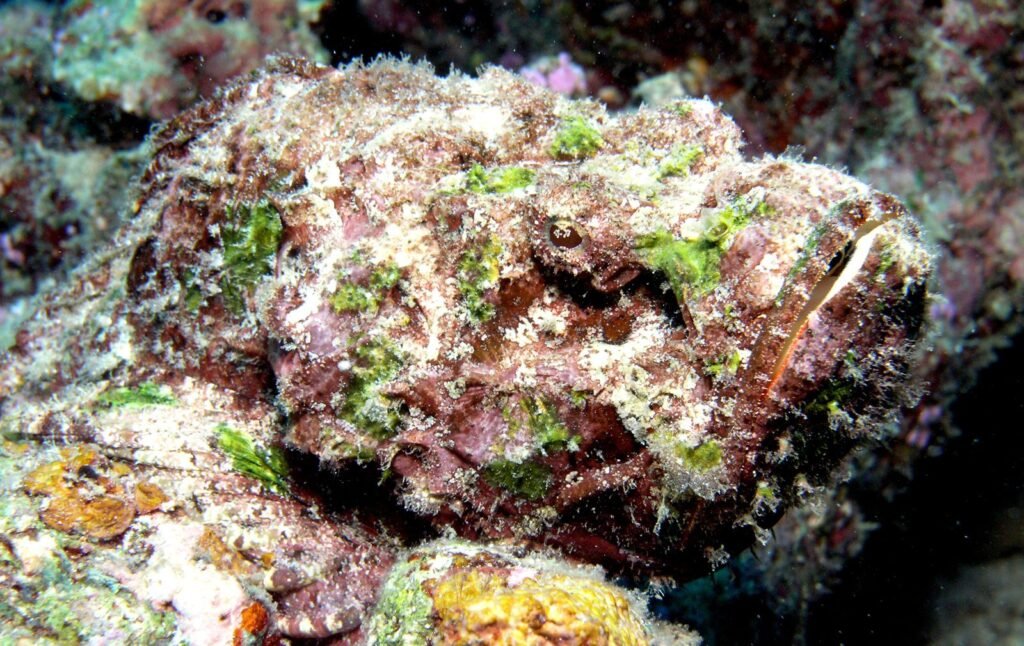
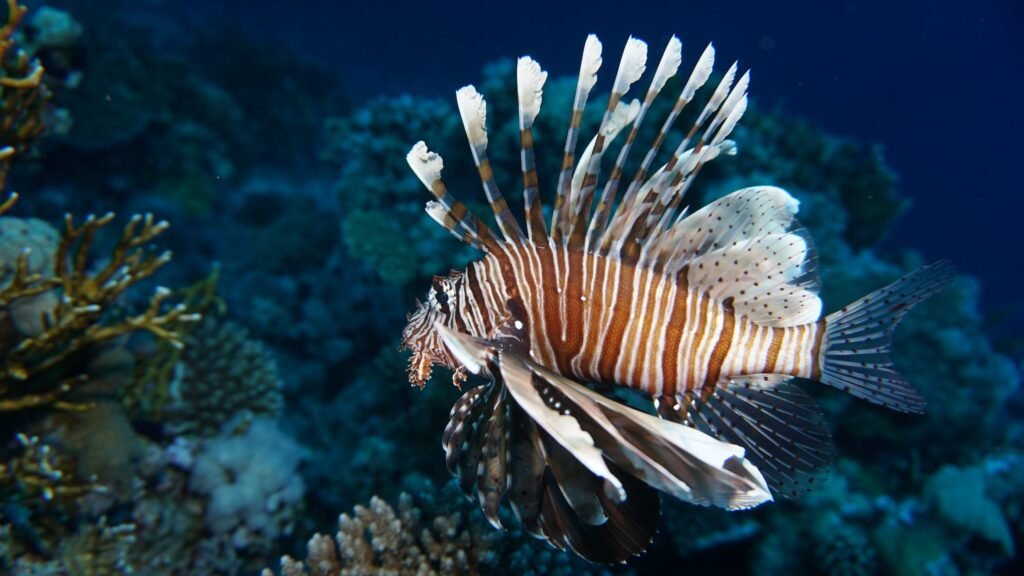
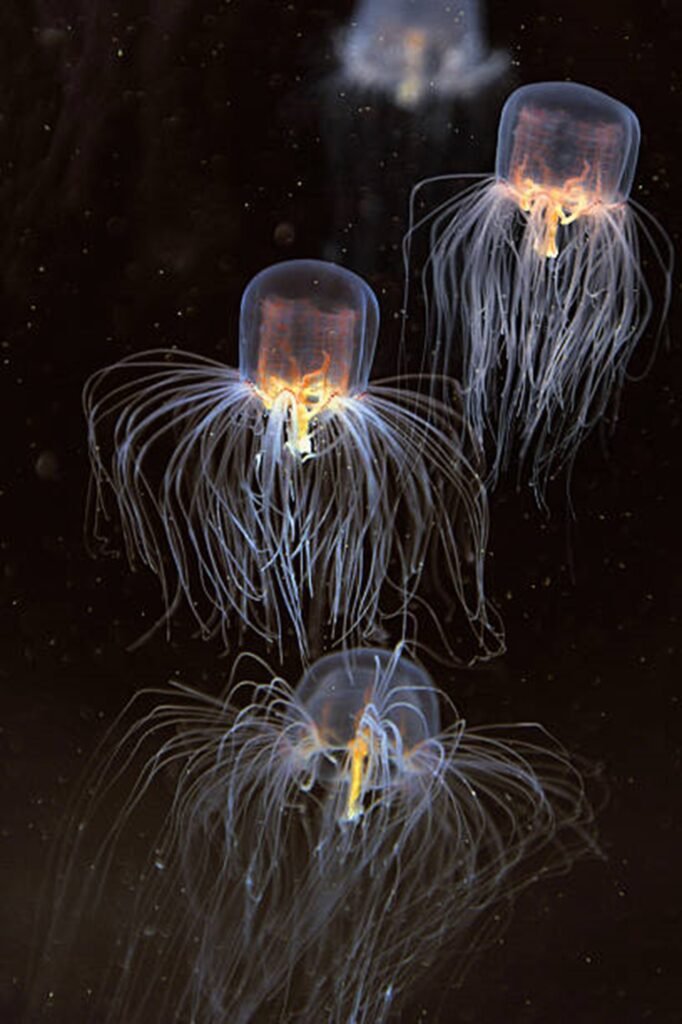
You wouldn’t be surprised to learn that there are other threats lurking beneath the surface if you’ve ever spent some time comparing deep-sea species. The most poisonous marine species in the water, according to the NOAA, is the Australian box jellyfish. These possible dangers include barracuda, which may attack at high to 25 miles per hour, and Pufferfish, which have poisons in their bodies that can kill thirty adult persons (for which there is no known remedy). Lionfish looks very beautiful. But the poisonous sting of a Lionfish can result in severe pain, perspiration, breathing difficulties, and even paralysis. When an Sea Urchin’s spine pierces a person’s flesh, it can cause tremendous pain. Urchins are most frequently found in shallow seas close to rocky or sandy shorelines and on subtropical coral reefs. When a Stonefish is accidentally trodden on, mistaken for a harmless rock, its dorsal spines will erupt, releasing venom from two sacs located at the base of each spine. It goes without saying that the more venom injected, the worse it gets for you. Horrible agony, edema, necrosis (death of tissue), and even death is caused by stings. Hence these dangerous creatures are the scariest things about ocean tales.
FAQs
What are the most scariest things about ocean ?
- Most of the ocean is undiscovered
- The ocean’s bottom depth is around 36,200 feet deep.
- The majority of the ocean is completely black.
- There are dangerous creatures in the depth of the ocean
- Ocean has enormous number of viruses
- Ocean has mysterious Bermuda triangle
Why Mariana Trench is considered the scariest things about ocean?
The Mariana Trench, a chasm in the western Pacific Ocean that stretches more than 1,580 miles (2,540 kilometres) and is home to the Challenger Deep, the deepest known point on Earth’s surface that descends more than 36,000 feet (roughly 11,000 meters) underwater, is arguably the most fascinating of these features.
Are there monsters in the ocean that we don’t know about?
The ocean is home to many mysterious and undiscovered species, but there are no actual sea monsters. However, some deep-sea creatures might appear frightening due to their unique adaptations.
Why sunlight cannot pass through the ocean water?
The scariest things about ocean are its darkness. The ocean is incredibly deep; light can only go approximately beyond the ocean’s surface. The molecules in the water scatter and absorb the light energy as it passes through them. Light scatters so much at extreme depths
What is the “Midnight Zone,” and why is it considered to be the scariest things about ocean?
The Midnight Zone refers to the darkest depths of the ocean where sunlight cannot penetrate. It’s scary due to extreme pressure, low temperatures, and the unknown species that inhabit this mysterious environment.
Are there real-life sea monsters like in movies?
No, there are no mythical sea monsters in reality. However, some deep-sea creatures, like the colossal squid, can be quite large and intimidating.
Can underwater volcanoes in the ocean pose a threat?
Underwater volcanoes, while fascinating, can pose threats such as eruptions and gas releases. Monitoring systems help scientists keep track of potential hazards.
How common are shark attacks in the ocean?
Shark attacks are rare, and sharks play a vital role in maintaining marine ecosystems. Understanding shark behavior and following safety guidelines reduce the risk of encounters.
Can you encounter dangerous marine creatures near the shore?
Certain marine creatures, like jellyfish and some species of fish, can be harmful. Being aware of local hazards and practicing safety precautions can prevent encounters.
How many shipwrecks are there under the ocean?
An estimated three million shipwrecks may be found strewn across the ocean floor, ranging from little abandoned dinghies to sunken World War II destroyers and historic Spanish galleons
Why is Bermuda Triangle mysterious?
In the Bermuda Triangle the forces are severe, unpredictable and incalculable storms may occur that intensify swiftly before dissipating. There is some force which sucks objects that moves above the Bermuda triangle
Remember that while the ocean has its share of mysteries and potential dangers, understanding and respecting its forces can enhance our appreciation for this remarkable and essential part of our planet.
Check out my other blogs Click here
